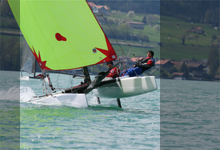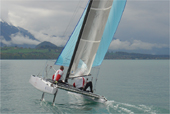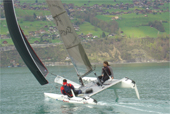


| 18HT Swiss Cup 2009 |
| Press |
| Design |
| Association |
| Regattas |
| Links |
| Trim |
| Galleries |
| Home |
Our thanks go to the American 18HT Association which gave us the generous permission to publish the following text.
Introduction
A lot of people have been really helpful with advice, including my son Nick, Randy Smyth, WF, Mark Murray, Bob Hodges, Pete Melvin, Charlie Ogletree, Peter Katcha, and Jay Glaser. Thanks to everyone in this class for sharing their experience.
I thought I’d write down exactly what I’ve learned. First, it’d help me remember this stuff before I forget it. Secondly, there is no established tuning & boatspeed manual. I do not have years of cat racing and the resultant instincts, so I’m trying to remember all of this stuff. Finally, it’s a start. Some stuff here may be plain wrong? You’re welcome to argue, refine, and rewrite this brief guide as better techniques are proven. Discussion will add to everyone’s knowledge.
Before heading out, set your diamonds between 37-42 on a new LOOS gauge. And make sure your mast is straight side to side. If you have a Petrucci mainsail, set up with less diamond tension and prebend. Maybe 37 and 1.25” prebend? We’re now at 39 with the Ullman mainsail and 1.75” of pre-bend. We seem to improve every time we add a turn of tension to the diamonds. Be warned: You’ll be set up too loose if the gauge is old and has lost its spring.
As best I can tell, there are three gears to upwind and downwind sailing. Base everything on the upwind mode, and the downwind advice will get you into the ballpark until you develop your own feel.
First gear: Underpowered and neither crew trapezing.
Upwind
Tacking angles between 90-100 degrees.
Mast rotater should be pointing at the front of the daggerboard case
Cunningham should be on moderately to help flatten the sail.
Outhaul adjusted so that the foot at the mid-point has about 4-5” of depth.
Mainsheet should be tightened so that tell-tales on the 3rd and 4th battens down are stalling on occasion. Adjust sheet tension to every gust/lull to keep the tell-tales occasionally stalling.
Both crew should be forward of the side shroud, and to windward. Crew may opt to be forward of the main crossbeam. This minimizes gurgling off the leeward transom.
Do not pinch. Keep your tell-takes along the luff flowing at all times.
Basically sail is flat, sheeted somewhat hard, and mast in high lift mode.
Downwind
Gybing angles between 100-110 degrees.
Let off mast rotater and cunnigham completely.
Crew to leeward on the main crossbeam.
Helmsperson is to windward and between the side shroud and main crossbeam on the net.
If you have time, daggerboards up 1-2’, but not critical.
Strap in the asymmetrical, head up, and try to wild thing. You will never lose ground by sailing hot angles in the 18HT. Trying to bear off for a more VMG course just is not as fast.
Second gear: From nearly single trapeze to fully double trapezed
Upwind
Tacking angles 80-90 degrees.
Mast rotater should be aimed at the back of the daggerboard trunk, or even further aft. If the boat feels ‘stuck’ rotate the mast further aft.
Cunningham should be just taking wrinkles out. So eased off from 1st Gear.
Outhaul can remain at 4-5” of depth at mid boom.
Mainsheet should be tightened so that tell-tales on the 3rd and 4th battens down are stalling on occasion. Adjust sheet tension to every gust/lull to keep the tell-tales occasionally stalling.
As soon as the crew hooks up, the helm can be aft of the side shroud. Crew just aft of the main crossbeam.
Do not pinch. The luff tell-tales should flow straight back.
Basically, the sail is in full power mode, and the mast is in low drag mode.
Downwind
Gybing angle about 90 degrees.
Let off mast rotater and cunnigham completely.
Crew position is in the center of the trampoline. Can go to leeward if you need to sail lower to a mark. And higher if coming in hot to a mark.
Helmsperson is to windward and behind the side shroud and main crossbeam on the net.
If you have time, daggerboards up 1-2’, but not critical.
Strap in the asymmetrical, head up, and fly a hull. Keep the weather hull out at all times.
Third gear: Overpowered while double trapezed
Upwind
Tacking angles at about 80 degrees.
Mast rotater should be aimed between the back of the daggerboard trunk and the aft beam end. The mast should bend sideways to leeward at the tip.
Cunningham should be pulled on until you do not have to play the mainsheet so much. Let the mast tip do the bending in gusts.
Outhaul should have 2” of depth at mid boom.
Mainsheet should be eased in gusts. When sheeted tight in lulls, you should be at the perfect power. If still overpowered, pull on more Cunningham. If underpowered, ease it off some.
Helm and crew on either side of the side shroud. In big gusts, move back 3-4”. In big lulls, move forward 3-4”. If you ever crack off, move back 2-3’.
Footing is fast, and luff tell-tales flowing straight back. For teams weighing under 300 lbs, it can pay to go into total pinch mode with the main strapped in. If you find you do not have a ‘low and fast mode’, this can be effective until you sort out how to put the bows down and jam.
Basically, the sail is in fully depowered blade mode, and the mast is in low drag mode.
Downwind
Gybing angles range from 65-80 degrees.
Let off mast rotater and cunnigham completely.
Crew position is either on the rail, or single wiring at the aft extremity of the boat.
Helmsperson is sitting on the rail with the tiller extension and tiller crossbar in one hand to keep the extension away from the crew’s face.
If you have time, daggerboards up 1-2’, but not critical.
The goal is simply to keep the weather hull out as much as possible. If a big gust is coming, put both hulls in the water for added buoyancy at the bows. If the bows go under to the main crossbeam, the crew needs to collapse the asymmetrical to prevent pitchpoling.
Some teams advocate double trapezing downwind in these conditions. The risk may not be worth the reward if there’s any chance of pitchpoling in chop. When sailing with my son, we’ve been plenty fast with no one on the wire.
Asymmetric is sheeted just tighter than a curl, at whatever angle hull flying dictates.
Peter Johnstone belongs to the founders of the 49er class. All his references are top shots out of olympic participants, Little-Americas Cup winners or US national champions.

